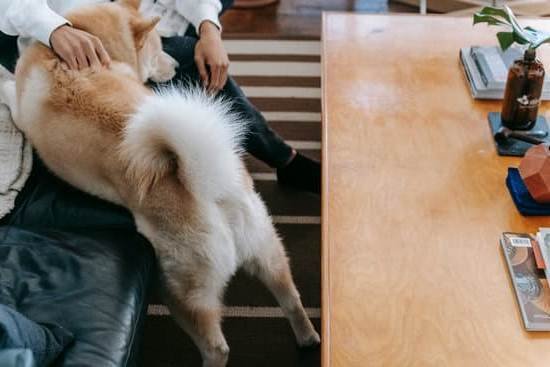Are you wondering how to train your dog to ring a bell to pee? Potty training is an essential aspect of owning a dog, and teaching them to communicate when they need to go outside can make the process much smoother. Using a bell as a communication tool can be convenient and efficient for both you and your furry friend.
Potty training is not only about preventing accidents in the house, but it also promotes good behavior and strengthens the bond between you and your dog. By teaching them to signal when they need to go outside, you are giving them a means of communication that reduces frustration for both parties.
Understanding your dog’s communication signals is crucial in potty training. Recognizing their behavior and body language when they need to pee is the first step in training them to use a bell. Positive reinforcement plays a significant role in this process, as it encourages desirable behavior by rewarding it with praise or treats. Through positive reinforcement, dogs can learn new behaviors such as ringing a bell when they need to relieve themselves.
Understanding a Dog’s Communication Signals
Dogs communicate their needs and emotions through various signals, including body language, vocalization, and behavioral cues. When it comes to potty training, it is crucial for pet owners to understand the specific signals that indicate when their dog needs to go outside to pee. By recognizing these signals, owners can effectively train their dogs to use a bell to communicate their need to go outside.
Behavior and Body Language
One of the most common indicators that a dog needs to urinate is restlessness or pacing. Dogs may also sniff around, circle a specific area, or suddenly become alert and focused on the door. Additionally, some dogs may whine or scratch at the door as an indication that they need to relieve themselves. Understanding these behavioral cues can help owners respond promptly and facilitate effective communication with their pets.
Positive Reinforcement in Bell Training
Using positive reinforcement techniques is essential when training a dog to ring a bell to signal their need to pee. This involves rewarding the desired behavior (ringing the bell) with a treat or praise.
By associating the act of ringing the bell with a positive outcome, such as going outside for a walk or receiving a reward, dogs learn to repeat this behavior when they need to urinate. Positive reinforcement creates a strong incentive for dogs to use the bell consistently and effectively.
By recognizing and interpreting their dog’s communication signals, pet owners can implement successful potty training strategies using a bell. Understanding the importance of positive reinforcement and consistency in training will ultimately lead to effective communication between dogs and their owners when it comes to bathroom breaks.
Selecting the Right Bell for Training
When it comes to training your dog to ring a bell to signal their need to go outside and pee, selecting the right bell is crucial. There are various types of bells available in the market, including jingle bells, potty training doorbells, and hanging bells. It’s essential to choose a bell that is durable, easy for your dog to use, and produces a clear sound that can be easily heard.
One popular option for bell training is using jingle bells that can be easily attached to a string or ribbon. These bells are lightweight and produce a distinct sound that can grab your dog’s attention. Another option is potty training doorbells that are designed specifically for this purpose. These doorbells usually have built-in mechanisms that dogs can easily press with their nose or paw to create a ringing sound.
It’s important to consider your dog’s size and demeanor when choosing a bell for training. For larger dogs, you may need a sturdier bell that can withstand more forceful interactions, while smaller dogs may prefer lighter bells with softer sounds. Additionally, some dogs may be intimidated by certain types of bells, so it’s essential to observe your dog’s reaction when introducing them to different options.
Overall, the key is to select a bell that is appealing and user-friendly for your dog while being durable enough to withstand repeated use. By choosing the right bell, you set the stage for successful potty training through bell ringing.
| Bell Type | Suitability |
|---|---|
| Jingle Bells | Lightweight and produces clear sound |
| Potty Training Doorbells | Designed specifically for training purposes with built-in mechanisms |
| Hanging Bells | May vary in size, weight and sound quality; suitability depends on individual preferences of both owner and pet. |
Introducing the Bell to Your Dog
When it comes to potty training your dog, communication is key. Introducing a bell for your dog to ring when they need to go outside can be a game-changer in effectively understanding and meeting your pet’s needs. Here’s how to introduce the bell to your dog and begin the process of training them to use it.
Steps for Introducing the Bell
- Start by selecting a bell that is easily accessible and durable for your dog
- Place the bell near the door that you typically use to take your dog outside
- Encourage your dog to interact with the bell by sniffing or touching it
- Associate the bell with going outside by ringing it yourself before opening the door
- Use treats or positive reinforcement to create a positive association with the bell
By following these steps, you can help familiarize your dog with the bell and begin building a connection between ringing the bell and going outside to pee.
Tips for Getting Your Dog Comfortable With the Bell
- Be patient – Some dogs may be hesitant at first, so allow them time to adjust at their own pace
- Ensure that the bell is easily reachable for your dog, especially if they are smaller or have mobility challenges
- Consistently use verbal cues when introducing the bell, such as saying “outside” or “potty time” before allowing them to ring it
- Reinforce positive behavior by offering praise or treats each time your dog interacts with the bell in a way that indicates their need to go outside
Remember that every dog is different, so it’s important to tailor your approach based on their individual personality and behavior. With patience and consistency, you can successfully train your dog to ring a bell when they need to pee.
Training Techniques for Bell Ringing
Training your dog to ring a bell to signal their need to go outside can be a highly effective and convenient way of potty training. By teaching your dog this behavior, you are providing them with a clear and consistent communication method, which can reduce accidents in the house and strengthen the bond between you and your pet. In this section, we will explore various training techniques for teaching your dog to ring a bell.
Positive Reinforcement
Using positive reinforcement is key in training your dog to ring a bell. When your dog rings the bell, immediately reward them with praise, treats, or whatever motivates them. This positive association will encourage them to repeat the behavior. It’s important to be consistent with the rewards and offer them every time your dog rings the bell.
Shaping Behavior
Shaping behavior involves breaking down the desired behavior into smaller achievable steps. Start by rewarding any interaction with the bell, then gradually narrow it down to only rewarding when they intentionally ring it with their paw or nose. This gradual approach helps your dog understand what specific action leads to a reward.
Consistency and Patience
Consistency is crucial in training your dog to ring a bell. Set up regular times throughout the day for potty breaks and encourage your dog to use the bell each time they need to go outside. Additionally, be patient with your pet as they learn this new skill. Some dogs may take longer than others to grasp the concept, so it’s essential to remain patient and not get discouraged.
By incorporating these training techniques into your routine, you can effectively teach your dog how to use a bell as a communication tool for potty breaks. Remember that every dog is unique, so it’s important to tailor the approach based on their individual learning style and personality. With consistency, patience, and positive reinforcement, you can successfully train your dog to ring a bell when they need to pee.
Reinforcing the Learned Behavior
Once your dog has successfully learned to ring a bell to signal their need to go outside, it is important to reinforce this behavior to ensure consistency. Positive reinforcement is key in maintaining the learned behavior of bell ringing for potty training. Whenever your dog rings the bell and successfully goes outside to pee, be sure to praise and reward them with treats or verbal affirmation. This will help solidify the association between ringing the bell and going outside.
Consistency is also crucial in reinforcing the learned behavior. It’s important to always respond promptly when your dog rings the bell, even if you may not think they need to go outside every time. By consistently acknowledging their signal and taking them out, you are reinforcing the action of bell ringing as a communication for potty needs.
Another strategy for reinforcing the learned behavior is by incorporating regular practice sessions into your dog’s routine. Even after your dog has mastered ringing the bell, it’s beneficial to continue practicing occasionally to maintain their proficiency and ensure that they don’t forget their training.
| Reinforcement Strategy | Description |
|---|---|
| Positive Reinforcement | Consistently rewarding your dog for ringing the bell and going outside. |
| Consistent Response | Always responding promptly when your dog rings the bell. |
| Regular Practice Sessions | Incorporating occasional practice sessions into your dog’s routine after they have mastered bell training. |
By employing these reinforcement strategies, you can effectively maintain your dog’s ability to ring a bell and ensure successful potty training. Remember that patience and consistency are key in reinforcing this learned behavior.
Troubleshooting and Fine-Tuning the Training
Training a dog to ring a bell to signal their need to go outside and pee can be a highly effective method for potty training. However, like any training process, there may be challenges and adjustments that need to be made along the way. It’s important to troubleshoot and fine-tune the training to ensure its success.
Here are some common mistakes to avoid in bell training:
- Using punishment or negative reinforcement
- Not being consistent with the training routine
- Expecting too much too soon from your dog
When it comes to troubleshooting and fine-tuning the training, it’s crucial to pay attention to your dog’s response and make necessary adjustments. This may involve revisiting certain steps of the training process or trying different techniques that better suit your dog’s learning style.
Here are some tips for adjusting the training approach based on the dog’s response:
- Assess your dog’s comfort level with the bell – if your dog seems hesitant or scared of the bell, consider using a smaller or softer alternative
- Observe your dog’s behavior when they need to pee – if they show signs of needing to go but don’t ring the bell, consider providing extra encouragement and reinforcement when they do use it
- Be patient and adaptable – every dog is unique, so be open to making changes in the training process based on what works best for your specific pet
By troubleshooting any issues that arise during bell training and fine-tuning the approach as needed, you can set your dog up for success in effectively using the bell as a communication tool for potty training. Remember that consistency and positive reinforcement are key factors in achieving this goal.
Maintaining the Bell Training
Once you have successfully trained your dog to ring a bell when they need to go outside to pee, it is important to maintain this behavior to ensure continued success. Consistency is key in reinforcing the bell ringing behavior, and there are several strategies that can help you maintain this training over time.
One effective strategy for maintaining the bell training is to continue using positive reinforcement. Whenever your dog rings the bell and goes outside to pee, be sure to reward them with treats and praise. This positive association will encourage them to continue using the bell as a signal for their potty needs.
Another way to maintain the bell training is by establishing a routine. Dogs thrive on consistency and having a set schedule for potty breaks can help reinforce the bell ringing behavior. Take your dog outside at regular intervals and encourage them to ring the bell each time before going out.
It is also important to regularly check in on your dog’s progress with the bell ringing training. If you notice any changes in their behavior or if they begin to have accidents inside, revisit the training techniques and make any necessary adjustments. Remember that patience and persistence are key when maintaining the bell training for potty purposes.
Overall, by consistently using positive reinforcement, establishing a routine, and staying attentive to your dog’s progress, you can effectively maintain the bell training for successful potty habits.
Conclusion
In conclusion, training your dog to ring a bell to signal their need to go outside and pee can be an incredibly useful and efficient method of potty training. By understanding your dog’s communication signals and using positive reinforcement, you can successfully teach them this valuable skill.
Selecting the right bell for training is essential, as it should be durable and easy for your dog to use. Introducing the bell to your dog gradually, getting them comfortable with it, and then using various training techniques for bell ringing will help reinforce the behavior.
Consistency and patience are crucial throughout the training process. It’s important to consistently reinforce the learned behavior and address any challenges that may arise during the training period. Additionally, maintaining the bell ringing behavior requires continued reinforcement and consistency in training. Successful potty training with bell ringing ultimately relies on your dedication as a pet owner in teaching and supporting your dog throughout their learning journey.
We hope that this article has provided you with valuable insights on how to train a dog to ring a bell to pee effectively. With dedication, patience, and the right approach, you can successfully potty train your furry friend using this method.
Remember that every dog is unique, so it’s essential to adjust the training approach based on your dog’s individual response. We encourage all readers to embrace this approach and remain patient and consistent as they work towards successful potty training with their canine companions.

Welcome to the blog! I am a professional dog trainer and have been working with dogs for many years. In this blog, I will be discussing various topics related to dog training, including tips, tricks, and advice. I hope you find this information helpful and informative. Thanks for reading!





